Foliar Moisture Content from the Spectral Signature for Wildfire Risk Assessments in Valparaíso-Chile
Abstract
1. Introduction
2. Materials and Methods
Water Content and Vegetation Indexes
3. Results
4. Discussion
5. Conclusions
Author Contributions
Funding
Acknowledgments
Conflicts of Interest
Appendix A. Linear Regression Fitting of Indexes
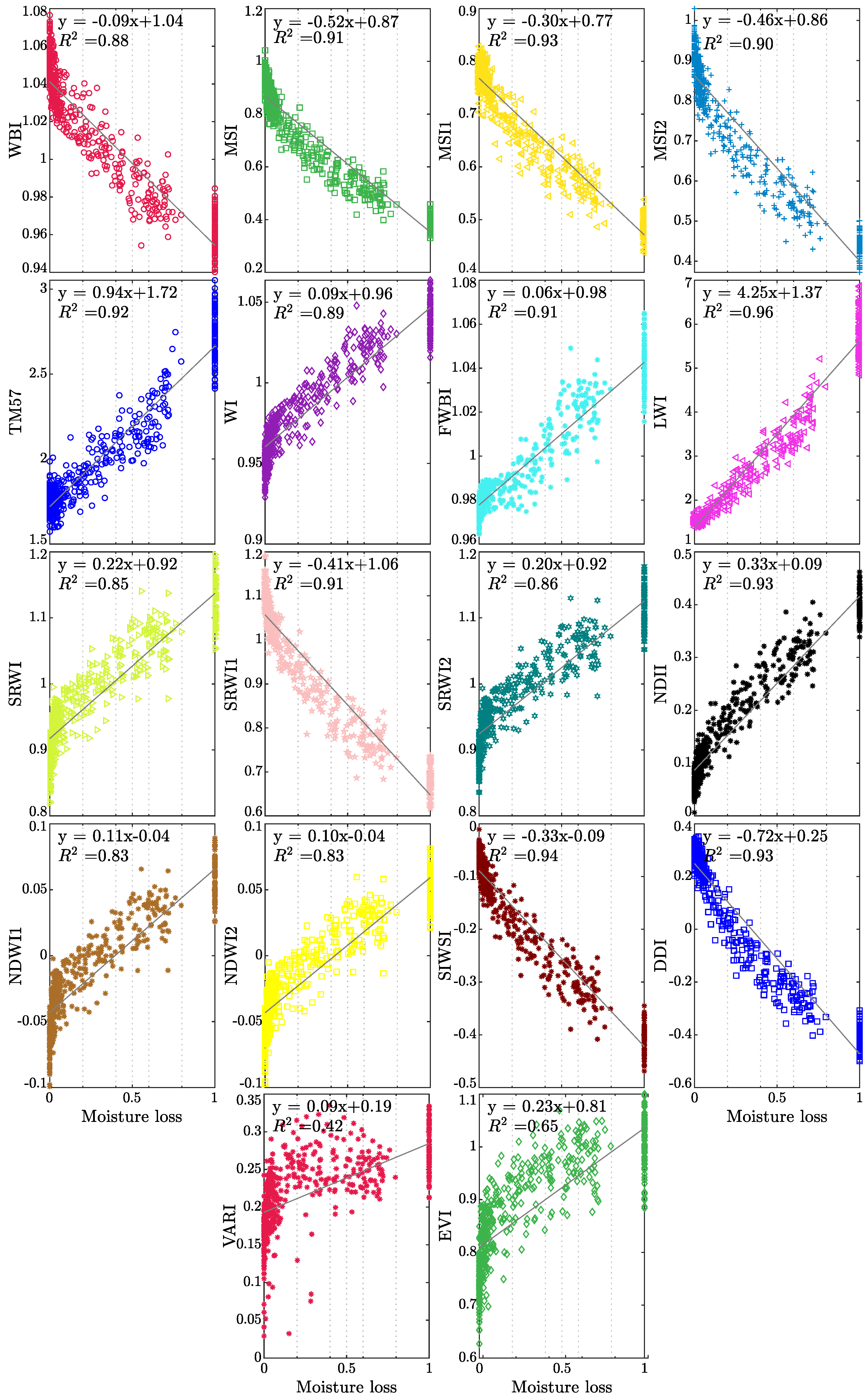
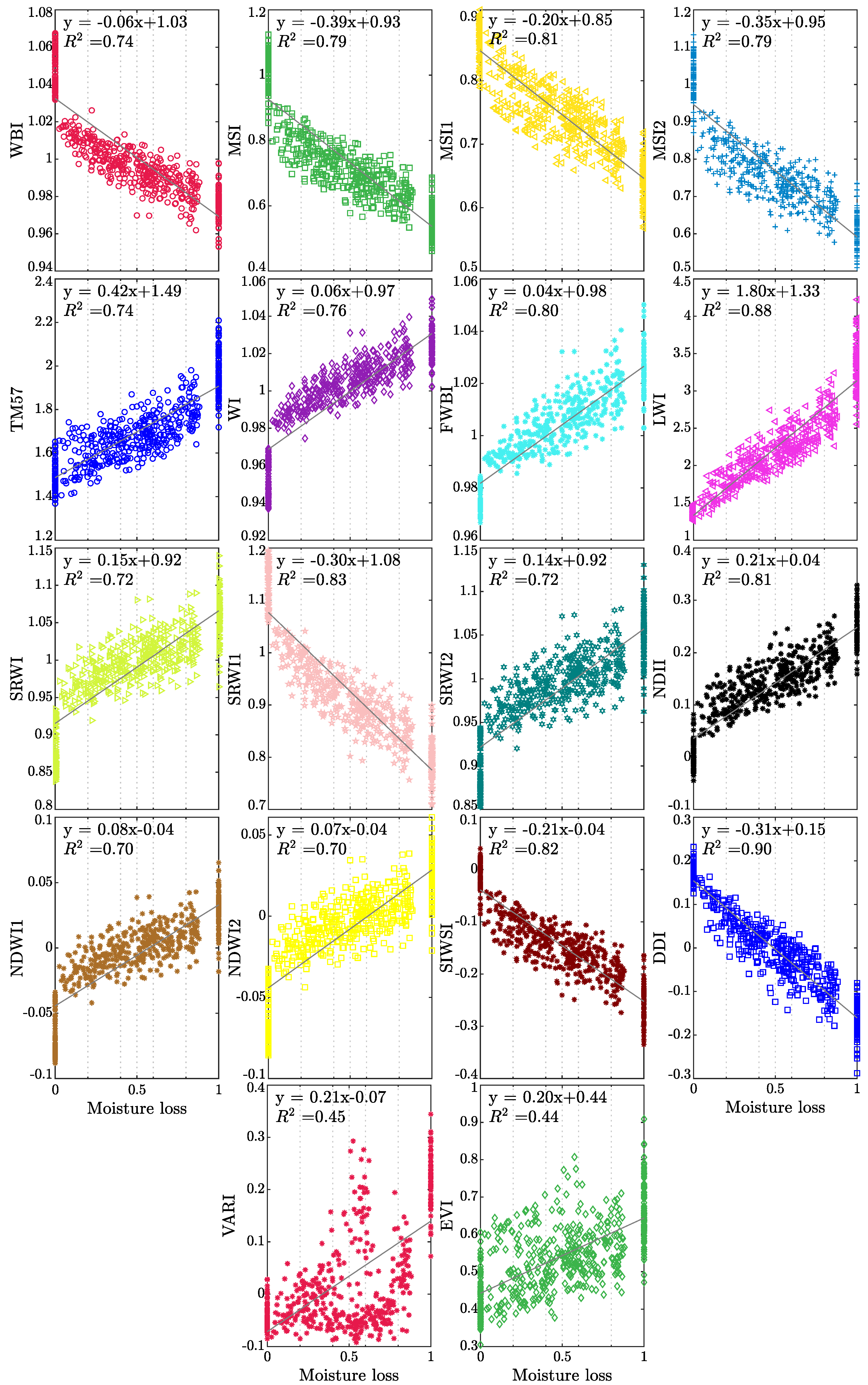
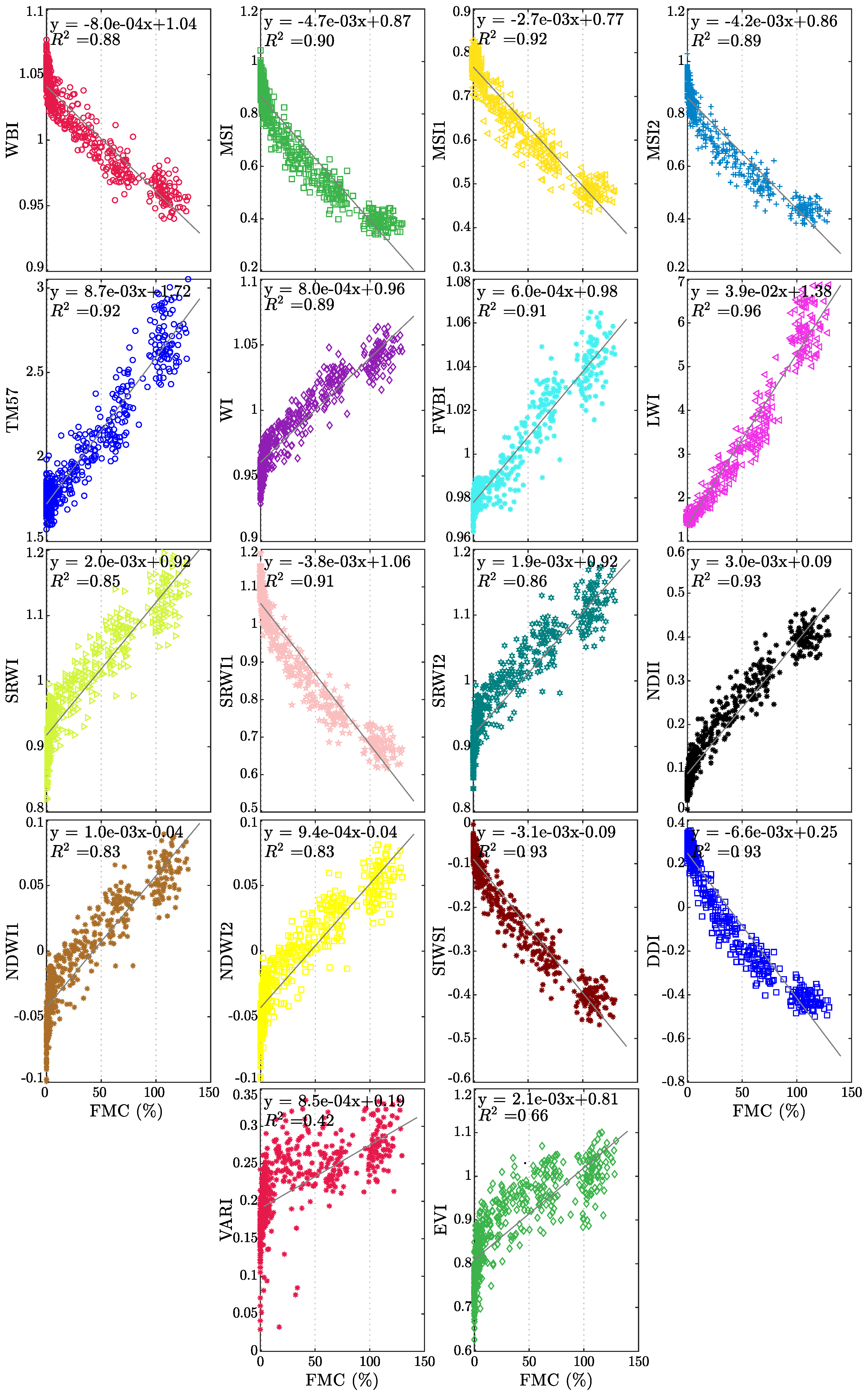
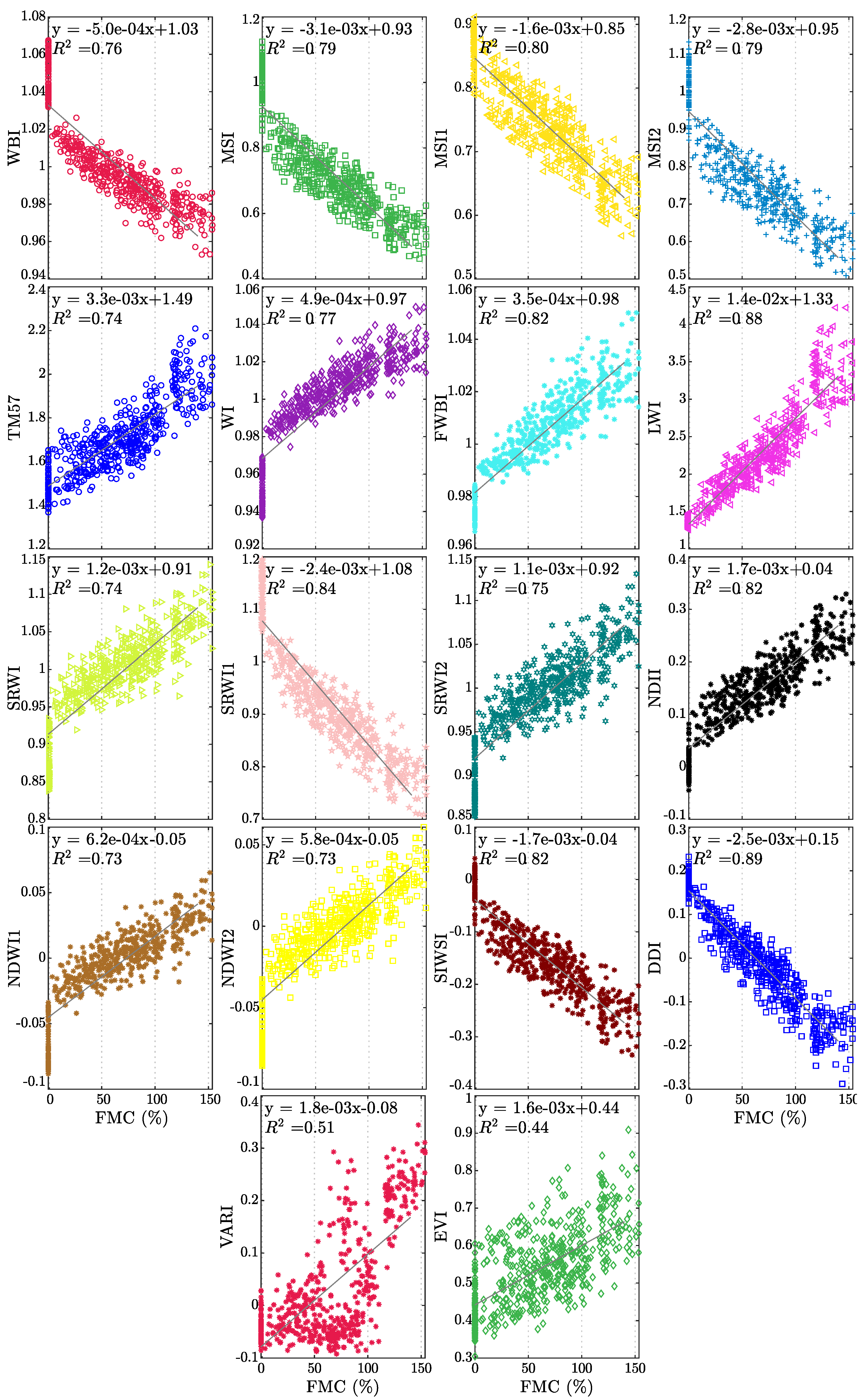
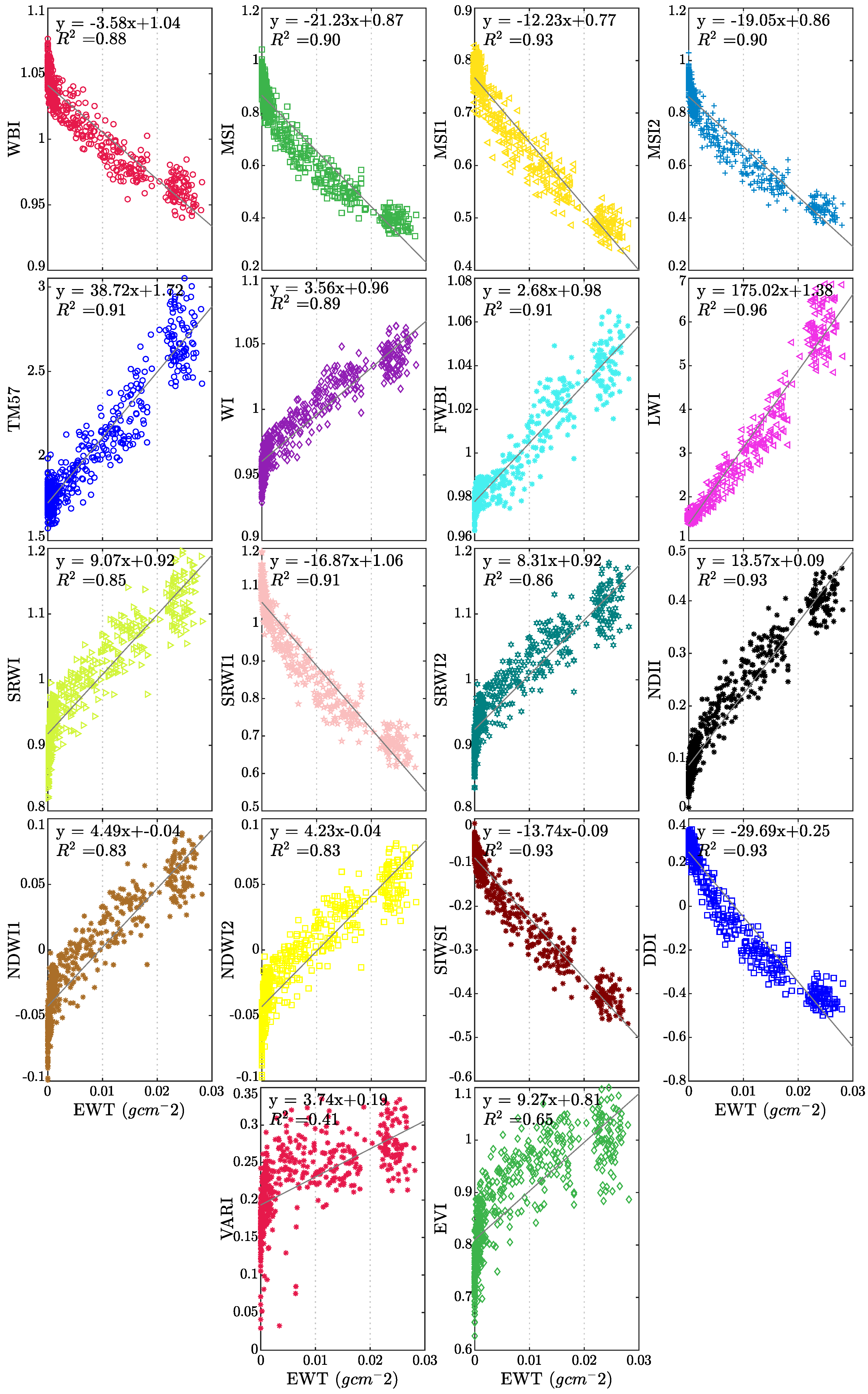
References
- Reszka, P.; Fuentes, A. The Great Valparaiso Fire and Fire Safety Management in Chile. Fire Technol. 2015, 51, 753–758. [Google Scholar] [CrossRef]
- Soto, M.C.; Julio-Alvear, G.; Salinas, R.G. Chapter 4—Current Wildfire Risk Status and Forecast in Chile: Progress and Future Challenges. In Wildfire Hazards, Risks and Disasters; Shroder, J.F., Paton, D., Eds.; Elsevier: Oxford, UK, 2015; pp. 59–75. [Google Scholar] [CrossRef]
- Conaf, C.N.F. Estadísticas-Resumen Regional Ocurrencia (Número) y Daño (Superficie Afectada) por Incendios Forestales 1977–2018; Programa de Manejo del Fuego; Corporación Nacionial Forestal: Santiago, Chile, 2018. [Google Scholar]
- Heilmayr, R.; Echeverria, C.; Fuentes, R.; Lambin, E.F. A plantation-dominated forest transition in Chile. Appl. Geogr. 2016, 75, 71–82. [Google Scholar] [CrossRef]
- Gysling Caselli, A.J.; Alvarez González, V.; Soto Aguirre, D.A.; Pardo, V.; Poblete, P. Anuario Forestal 2018. In Chilean Statistical Yearbook of Forestry; INFOR: Santiago, Chile, 2018; Volume 163. [Google Scholar]
- Conaf, C.N.F. Estadísticas-Causas según Ocurrencia de Incendios Forestales 1987–2018; Programa de Manejo del Fuego; Corporación Nacionial Forestal: Santiago, Chile, 2018. [Google Scholar]
- Sección de Análisis y Predicción de Incendios Forestales CONAF—Frecuencia Incendios Forestales (2002–2019). Available online: https://conaf.carto.com/u/geprif (accessed on 24 May 2019).
- Rougier, J.; Sparks, S.; Hill, L. Risk and Uncertainty Assessment for Natural Hazards; Cambridge University Press: Cambridge, UK, 2013. [Google Scholar] [CrossRef]
- Vitolo, C.; Di Giuseppe, F.; Krzeminski, B.; San-Miguel-ayanz, J. Data descriptor: A 1980–2018 global fire danger re-analysis dataset for the Canadian fire weather indices. Sci. Data 2019, 6. [Google Scholar] [CrossRef] [PubMed]
- Mahmoud, H.; Chulahwat, A. Unraveling the Complexity of Wildland Urban Interface Fires. Sci. Rep. 2018, 8, 9315. [Google Scholar] [CrossRef] [PubMed]
- Fernandez-Pello, A.C. Wildland fire spot ignition by sparks and firebrands. Fire Saf. J. 2017, 91, 2–10. [Google Scholar] [CrossRef]
- Baines, P.G. Physical mechanisms for the propagation of surface fires. Math. Comput. Model. 1990, 13, 83–94. [Google Scholar] [CrossRef]
- Rossa, C.G.; Fernandes, P.M. Live Fuel Moisture Content: The ‘Pea Under the Mattress’ of Fire Spread Rate Modeling? Fire 2018, 1, 43. [Google Scholar] [CrossRef]
- Lawson, B.; Hawkes, B. Field evaluation of a moisture content model for medium-sized logging slash. In Proceedings of the 10th Conference on Fire and Forest Meteorology, Ottawa, ON, Canada, 17–21 April 1989; pp. 247–257. [Google Scholar]
- Yebra, M.; Dennison, P.; Chuvieco, E.; Riaño, D.; Zylstra, P.; Hunt, E.; Danson, F.; Qi, Y.; Jurdao, S. A global review of remote sensing of live fuel moisture content for fire danger assessment: Moving towards operational products. Remote Sens. Environ. 2013, 136, 455–468. [Google Scholar] [CrossRef]
- Yebra, M.; Quan, X.; Riaño, D.; Rozas Larraondo, P.; van Dijk, A.; Cary, G. A fuel moisture content and flammability monitoring methodology for continental Australia based on optical remote sensing. Remote Sens. Environ. 2018, 212, 260–272. [Google Scholar] [CrossRef]
- Quan, X.; He, B.; Yebra, M.; Yin, C.; Liao, Z.; Li, X. Retrieval of forest fuel moisture content using a coupled radiative transfer model. Environ. Model. Softw. 2017, 95, 290–302. [Google Scholar] [CrossRef]
- Peñuelas, J.; Filella, I.; Biel, C.; Serrano, L.; Save, R. The reflectance at the 950–970 nm region as an indicator of plant water status. Int. J. Remote Sens. 1993, 14, 1887–1905. [Google Scholar] [CrossRef]
- Hunt, E.R., Jr.; Rock, B.N. Detection of changes in leaf water content using near-and middle-infrared reflectances. Remote Sens. Environ. 1989, 30, 43–54. [Google Scholar] [CrossRef]
- Rock, B.N.; Vogelmann, J.E.; Williams, D. Field and airborne spectral characterization of suspected damage in red spruce (Picea rubens) from vermont. Remote Sens. Environ. 1985, 30, 71–81. [Google Scholar]
- Rock, B.; Vogelmann, J.; Williams, D.; Vogelmann, A.; Hoshizaki, T. Remote Detection of Forest Damage: Plant responses to stress may have spectral “signatures” that could be used to map, monitor, and measure forest damage. Bioscience 1986, 36, 439–445. [Google Scholar] [CrossRef]
- Elvidge, C.D.; Lyon, R.J. Estimation of the vegetation contribution to the 1· 65/2· 22 μm ratio in airborne thematic-mapper imagery of the Virginia Range, Nevada. Int. J. Remote Sens. 1985, 6, 75–88. [Google Scholar] [CrossRef]
- Peñuelas, J.; Pinol, J.; Ogaya, R.; Filella, I. Estimation of plant water concentration by the reflectance water index WI (R900/R970). Int. J. Remote Sens. 1997, 18, 2869–2875. [Google Scholar] [CrossRef]
- Zarco-Tejada, P.J.; Ustin, S. Modeling canopy water content for carbon estimates from MODIS data at land EOS validation sites. In Proceedings of the IGARSS 2001 Scanning the Present and Resolving the Future. IEEE 2001 International Geoscience and Remote Sensing Symposium (Cat. No. 01CH37217), Sydney, NSW, Australia, 9–13 July 2001; Volume 1, pp. 342–344. [Google Scholar]
- Gao, B.C. NDWI—A normalized difference water index for remote sensing of vegetation liquid water from space. Remote Sens. Environ. 1996, 58, 257–266. [Google Scholar] [CrossRef]
- Seelig, H.D.; Hoehn, A.; Stodieck, L.; Klaus, D.; Adams Iii, W.; Emery, W. The assessment of leaf water content using leaf reflectance ratios in the visible, near-, and short-wave-infrared. Int. J. Remote Sens. 2008, 29, 3701–3713. [Google Scholar] [CrossRef]
- Rodríguez-Pérez, J.R.; Riaño, D.; Carlisle, E.; Ustin, S.; Smart, D.R. Evaluation of hyperspectral reflectance indexes to detect grapevine water status in vineyards. Am. J. Enol. Vitic. 2007, 58, 302–317. [Google Scholar]
- Wang, Q.; Li, P. Hyperspectral indices for estimating leaf biochemical properties in temperate deciduous forests: Comparison of simulated and measured reflectance data sets. Ecol. Indic. 2012, 14, 56–65. [Google Scholar] [CrossRef]
- Hardisky, M.; Klemas, V.; Smart, M. The influence of soil salinity, growth form, and leaf moisture on the spectral radiance of. Spartina Alterniflora 1983, 49, 77–83. [Google Scholar]
- Fensholt, R.; Sandholt, I. Derivation of a shortwave infrared water stress index from MODIS near-and shortwave infrared data in a semiarid environment. Remote Sens. Environ. 2003, 87, 111–121. [Google Scholar] [CrossRef]
- Gitelson, A.; Kaufman, Y.; Stark, R.; Rundquist, D. Novel algorithms for remote estimation of vegetation fraction. Remote Sens. Environ. 2002, 80, 76–87. [Google Scholar] [CrossRef]
- Clevers, J.; Kooistra, L.; Schaepman, M. Estimating canopy water content using hyperspectral remote sensing data. Int. J. Appl. Earth Obs. Geoinf. 2010, 12, 119–125. [Google Scholar] [CrossRef]
- Jurdao, S.; Yebra, M.; Guerschman, J.; Chuvieco, E. Regional estimation of woodland moisture content by inverting Radiative Transfer Models. Remote Sens. Environ. 2013, 132, 59–70. [Google Scholar] [CrossRef]
- Conaf, C.N.F. Estadísticas-Ocurrencia y Daño por Incendios Forestales según Incendios de Magnitud 1985–2018; Programa de Manejo del Fuego; Corporación Nacionial Forestal: Santiago, Chile, 2018. [Google Scholar]
- Conaf, C.N.F.; Conama, C.N.d.M.A. Plantación Forestal; Chilean Forest Service: Santiago, Chile, 1997. [Google Scholar]
- Kumar, L. High-spectral resolution data for determining leaf water content in Eucalyptus species: Leaf level experiments. Geocarto Int. 2007, 22, 3–16. [Google Scholar] [CrossRef]
- Zarco-Tejada, P.J.; Rueda, C.; Ustin, S.L. Water content estimation in vegetation with MODIS reflectance data and model inversion methods. Remote Sens. Environ. 2003, 85, 109–124. [Google Scholar] [CrossRef]
- Madrigal, J.; Hernando, C.; Guijarro, M. A new bench-scale methodology for evaluating the flammability of live forest fuels. J. Fire Sci. 2013, 31, 131–142. [Google Scholar] [CrossRef]
- Qi, Y.; Dennison, P.E.; Jolly, W.M.; Kropp, R.C.; Brewer, S.C. Spectroscopic analysis of seasonal changes in live fuel moisture content and leaf dry mass. Remote Sens. Environ. 2014, 150, 198–206. [Google Scholar] [CrossRef]
- Chelli, S.; Maponi, P.; Campetella, G.; Monteverde, P.; Foglia, M.; Paris, E.; Lolis, A.; Panagopoulos, T. Adaptation of the Canadian fire weather index to Mediterranean forests. Nat. Hazards 2015, 75, 1795–1810. [Google Scholar] [CrossRef]
- TerraSpec User Manual. Available online: https://www.mapping-solutions.co.uk/downloads/data/pdf/A1044.pdf (accessed on 7 October 2019).
- Trabaud, L. Inflammabilité et combustibilité des principales espèces des garrigues de la région méditerranéenne. Oecologia Plant 1976, 11, 117–136. [Google Scholar]
- Caramelle, P.; Clément, A. Inflammabilité et Combustibilité de la Végétation Méditerrannéene; Institut National de la Recherche Agronomique (I.N.R.A.): Avignon, France, 1978. [Google Scholar]
- Valette, J. Inflammabilité, teneur en eau et turgescence relative de quatre espèces forestières méditerranéennes. In Documentos del Seminario sobre Métodos y Equipos para la Prevención de Incendios Forestales; Instituto Nacional para la Conservación de la Naturaleza, MAPA: Madrid, Spain, 1988; pp. 98–107. [Google Scholar]
- Elvira Martín, L.M.; Hernando Lara, C. Inflamabilidad y Energía de las Especies de Sotobosque; Instituto Nacional de Investigaciones Agrarias (INIA), Ministerio de Agricultura, Pesca y Alimentación: Madrid, Spain, 1989. [Google Scholar]
- Desbois, N.; Pereira, J.; Beaudoin, A.; Chuvieco, E.; Vidal, A. Short term fire risk mapping using remote sensing. In A Review of Remote Sensing Methods for the Study of Large Wildland Fires; Chuvieco, E., Ed.; Megafires Project ENV-CT96-0256: Alcalá de Henares, Spain, 1997; pp. 29–60. [Google Scholar]
- Asner, G.P.; Martin, R.E.; Tupayachi, R.; Emerson, R.; Martinez, P.; Sinca, F.; Powell, G.V.; Wright, S.J.; Lugo, A.E. Taxonomy and remote sensing of leaf mass per area (LMA) in humid tropical forests. Ecol. Appl. 2011, 21, 85–98. [Google Scholar] [CrossRef] [PubMed]
- Simeoni, A.; Thomas, J.; Bartoli, P.; Borowieck, P.; Reszka, P.; Colella, F.; Santoni, P.A.; Torero, J.L. Flammability studies for wildland and wildland–urban interface fires applied to pine needles and solid polymers. Fire Saf. J. 2012, 54, 203–217. [Google Scholar] [CrossRef]
- Jervis, F.X.; Rein, G. Experimental study on the burning behaviour of Pinus halepensis needles using small-scale fire calorimetry of live, aged and dead samples. Fire Mater. 2016, 40, 385–395. [Google Scholar] [CrossRef]
- Liu, N.; Wu, L.; Chen, L.; Sun, H.; Dong, Q.; Wu, J. Spectral Characteristics Analysis and Water Content Detection of Potato Plants Leaves. IFAC-PapersOnLine 2018, 51, 541–546. [Google Scholar] [CrossRef]
- Gameiro, C.; Utkin, A.; Cartaxana, P.; da Silva, J.M.; Matos, A. The use of laser induced chlorophyll fluorescence (LIF) as a fast and non-destructive method to investigate water deficit in Arabidopsis. Agric. Water Manag. 2016, 164, 127–136. [Google Scholar] [CrossRef]
- Ceccato, P.; Flasse, S.; Tarantola, S.; Jacquemoud, S.; Grégoire, J.M. Detecting vegetation leaf water content using reflectance in the optical domain. Remote Sens. Environ. 2001, 77, 22–33. [Google Scholar] [CrossRef]
- Cao, Z.; Wang, Q. Retrieval of leaf fuel moisture contents from hyperspectral indices developed from dehydration experiments. Eur. J. Remote Sens. 2017, 50, 18–28. [Google Scholar] [CrossRef]
- Wei, Y.; Wu, F.; Xu, J.; Sha, J.; Zhao, Z.; He, Y.; Li, X. Visual detection of the moisture content of tea leaves with hyperspectral imaging technology. J. Food Eng. 2019, 248, 89–96. [Google Scholar] [CrossRef]
- De Jong, S.M.; Addink, E.A.; Doelman, J.C. Detecting leaf-water content in Mediterranean trees using high-resolution spectrometry. Int. J. Appl. Earth Obs. Geoinf. 2014, 27, 128–136. [Google Scholar] [CrossRef]
- González-Fernández, A.B.; Rodríguez-Pérez, J.R.; Marcelo, V.; Valenciano, J.B. Using field spectrometry and a plant probe accessory to determine leaf water content in commercial vineyards. Agric. Water Manag. 2015, 156, 43–50. [Google Scholar] [CrossRef]
- El-Hendawy, S.E.; Al-Suhaibani, N.A.; Elsayed, S.; Hassan, W.M.; Dewir, Y.H.; Refay, Y.; Abdella, K.A. Potential of the existing and novel spectral reflectance indices for estimating the leaf water status and grain yield of spring wheat exposed to different irrigation rates. Agric. Water Manag. 2019, 217, 356–373. [Google Scholar] [CrossRef]
- Cao, Z.; Wang, Q.; Zheng, C. Best hyperspectral indices for tracing leaf water status as determined from leaf dehydration experiments. Ecol. Indic. 2015, 54, 96–107. [Google Scholar] [CrossRef]
- Danson, F.; Bowyer, P. Estimating live fuel moisture content from remotely sensed reflectance. Remote Sens. Environ. 2004, 92, 309–321. [Google Scholar] [CrossRef]
- Maki, M.; Ishiahra, M.; Tamura, M. Estimation of leaf water status to monitor the risk of forest fires by using remotely sensed data. Remote Sens. Environ. 2004, 90, 441–450. [Google Scholar] [CrossRef]
- Datt, B. Remote sensing of water content in Eucalyptus leaves. Aust. J. Bot. 1999, 47, 909–923. [Google Scholar] [CrossRef]
- Rodríguez-Pérez, J.; Ordóñez, C.; González-Fernández, A.; Sanz-Ablanedo, E.; Valenciano, J.; Marcelo, V. Leaf water content estimation by functional linear regression of field spectroscopy data. Biosyst. Eng. 2018, 165, 36–46. [Google Scholar] [CrossRef]
- Fang, M.; Ju, W.; Zhan, W.; Cheng, T.; Qiu, F.; Wang, J. A new spectral similarity water index for the estimation of leaf water content from hyperspectral data of leaves. Remote Sens. Environ. 2017, 196, 13–27. [Google Scholar] [CrossRef]
- Yi, Q.X.; Bao, A.M.; Wang, Q.; Zhao, J. Estimation of leaf water content in cotton by means of hyperspectral indices. Comput. Electron. Agric. 2013, 90, 144–151. [Google Scholar] [CrossRef]
- González-Fernández, A.; Rodríguez-Pérez, J.; Marabel, M.; Álvarez Taboada, F. Spectroscopic estimation of leaf water content in commercial vineyards using continuum removal and partial least squares regression. Sci. Hortic. 2015, 188, 15–22. [Google Scholar] [CrossRef]
- Kovar, M.; Brestic, M.; Sytar, O.; Barek, V.; Hauptvogel, P.; Zivcak, M. Evaluation of hyperspectral reflectance parameters to assess the leafwater content in soybean. Water 2019, 11, 443. [Google Scholar] [CrossRef]
- Chen, D.; Huang, J.; Jackson, T. Vegetation water content estimation for corn and soybeans using spectral indices derived from MODIS near- and short-wave infrared bands. Remote Sens. Environ. 2005, 98, 225–236. [Google Scholar] [CrossRef]
- Davidson, A.; Wang, S.; Wilmshurst, J. Remote sensing of grassland-shrubland vegetation water content in the shortwave domain. Int. J. Appl. Earth Obs. Geoinf. 2006, 8, 225–236. [Google Scholar] [CrossRef]
- Lei, J.; Yang, W.; Li, H.; Wu, M.; She, J.; Zhou, X.; Huang, B.; Zhang, Y.; Liu, L.; Luo, X. Leaf equivalent water thickness assessment by means of spectral analysis and a new vegetation index. J. Appl. Remote Sens. 2019, 13. [Google Scholar] [CrossRef]
- Han, D.; Liu, S.; Du, Y.; Xie, X.; Fan, L.; Lei, L.; Li, Z.; Yang, H.; Yang, G. Crop Water Content of Winter Wheat Revealed with Sentinel-1 and Sentinel-2 Imagery. Sensors 2019, 19, 4013. [Google Scholar] [CrossRef]
- Strachan, I.B.; Pattey, E.; Boisvert, J.B. Impact of nitrogen and environmental conditions on corn as detected by hyperspectral reflectance. Remote Sens. Environ. 2002, 80, 213–224. [Google Scholar] [CrossRef]
- Le Maire, G.; Francois, C.; Dufrene, E. Towards universal broad leaf chlorophyll indices using PROSPECT simulated database and hyperspectral reflectance measurements. Remote Sens. Environ. 2004, 89, 1–28. [Google Scholar] [CrossRef]
- Caccamo, G.; Chisholm, L.; Bradstock, R.; Puotinen, M.; Pippen, B. Monitoring live fuel moisture content of heathland, shrubland and sclerophyll forest in south-eastern Australia using MODIS data. Int. J. Wildl. Fire 2012, 21, 257–269. [Google Scholar] [CrossRef]
- Stow, D.; Niphadkar, M.; Kaiser, J. MODIS-derived visible atmospherically resistant index for monitoring chaparral moisture content. Int. J. Remote Sens. 2005, 26, 3867–3873. [Google Scholar] [CrossRef]
- Roberts, D.; Dennison, P.; Peterson, S.; Sweeney, S.; Rechel, J. Evaluation of Airborne Visible/Infrared Imaging Spectrometer (AVIRIS) and Moderate Resolution Imaging Spectrometer (MODIS) measures of live fuel moisture and fuel condition in a shrubland ecosystem in southern California. J. Geophys. Res. Biogeosci. 2006, 111. [Google Scholar] [CrossRef]
- Gao, X.; Huete, A.R.; Ni, W.; Miura, T. Optical–biophysical relationships of vegetation spectra without background contamination. Remote Sens. Environ. 2000, 74, 609–620. [Google Scholar] [CrossRef]

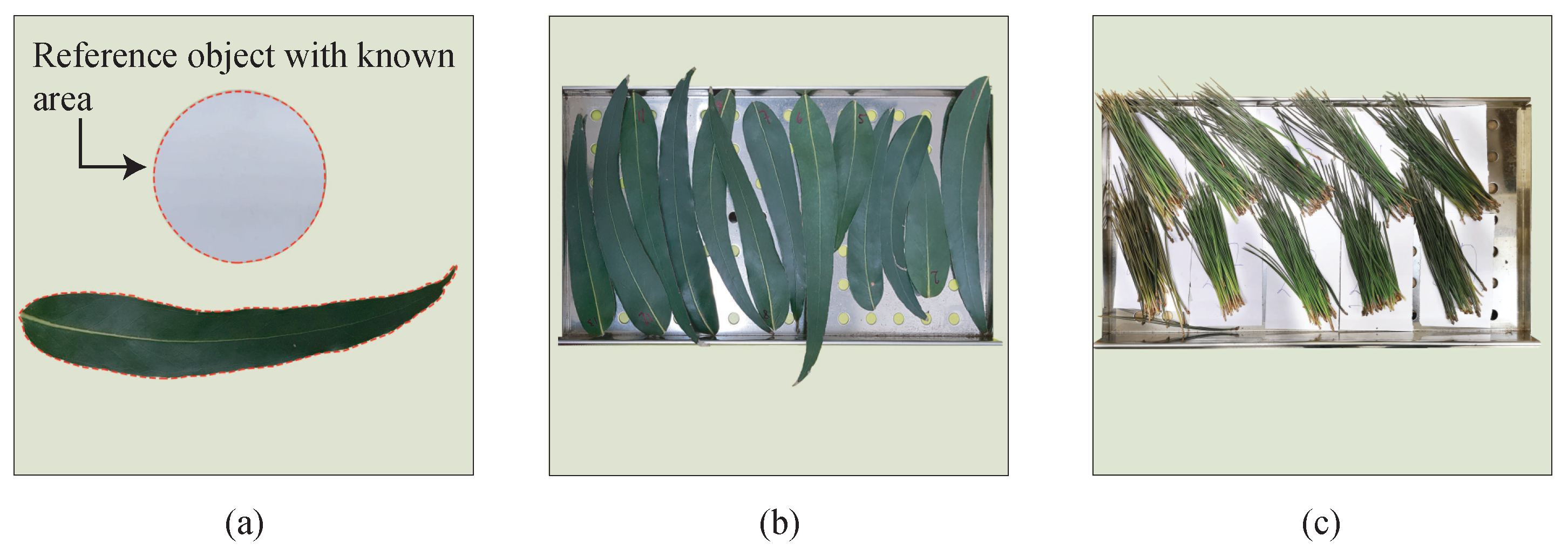
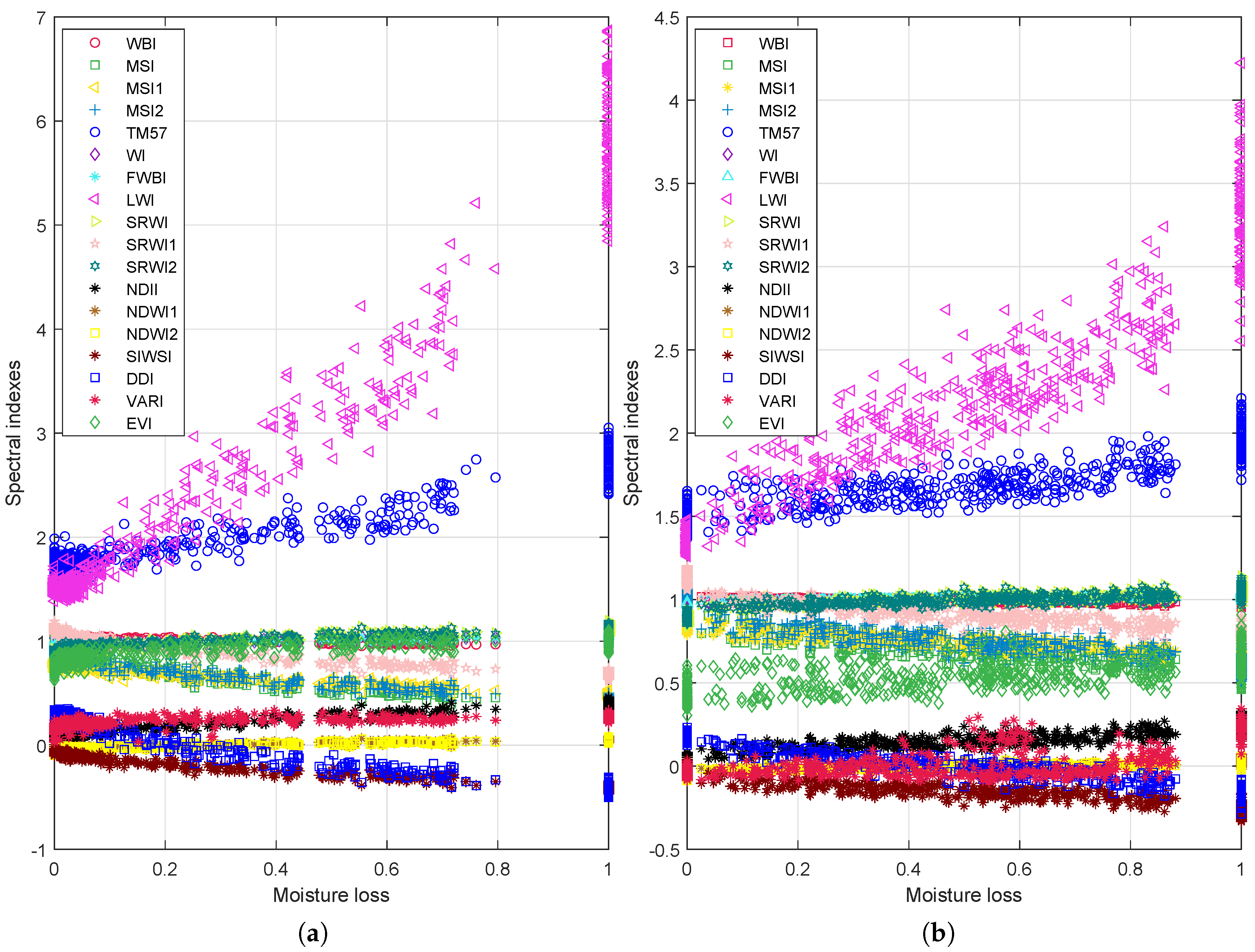
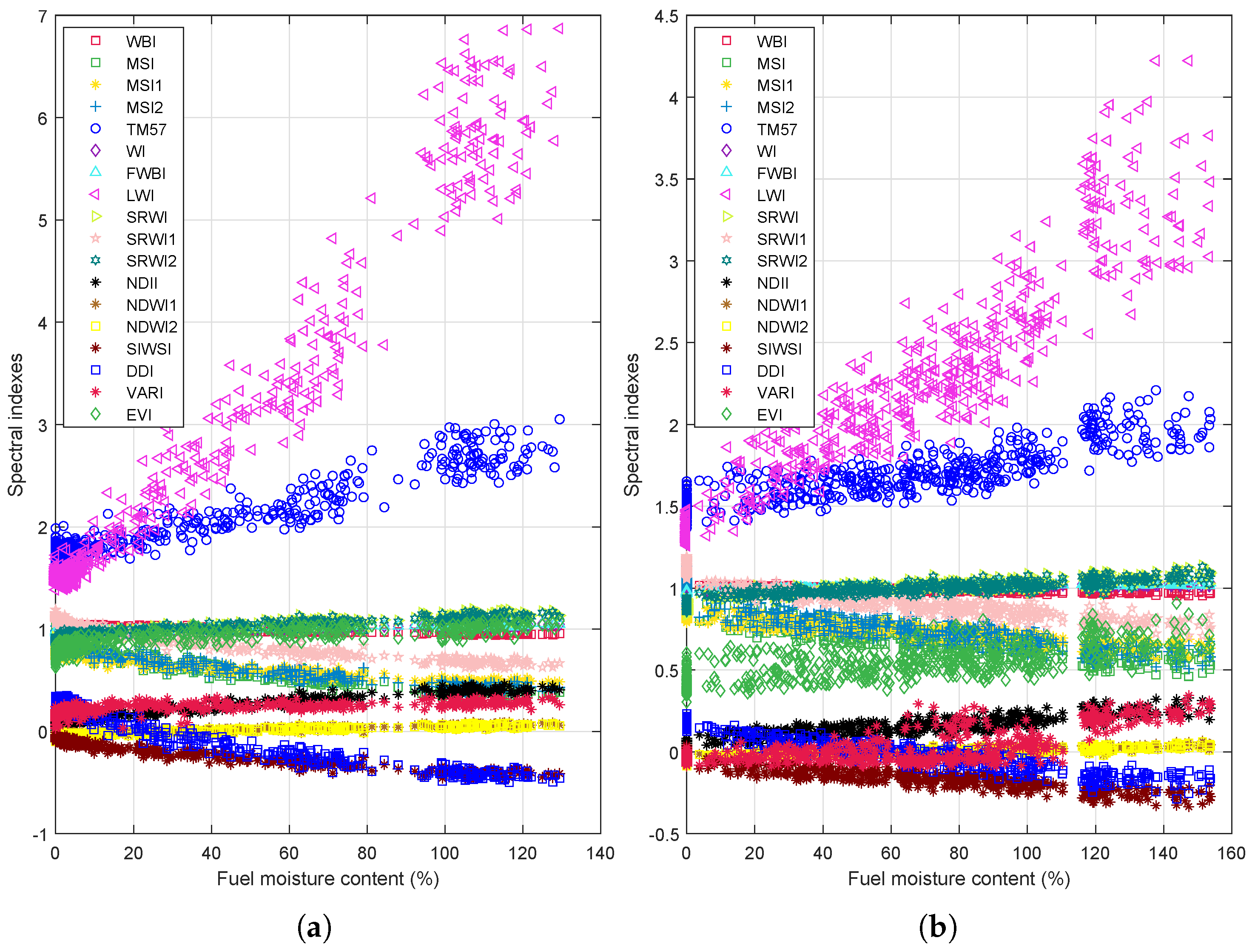

| Instrument | Technical Specifications |
|---|---|
| TerraSpec 4 Hi-Res Mineral spectrometer | Wavelength range: 350–2500 nm |
| Resolution: 3 nm at 700 nm and 6 nm at 1400/2100 nm | |
| Reproducibility: 0.1 nm | |
| Accuracy: 0.5 nm | |
| Balance Kern PFB 120-3 | Readability: 0.001 g |
| Maximum capacity: 120 g | |
| Universal Oven Memmert UN30 | Temperature: −5 C and +300 C respect the environmental temperature |
| Temperature control: Digital PID |
| Spectral Indexes | Equations |
|---|---|
| Water Band Index (WBI) is a good indicator of water status when the Relative Water Content (RWC) is smaller than 80–85 percent [18]. | |
| Moisture Stress Index (MSI) is correlated with the liquid water and MSI should be correlated with the Leaf Area Index (LAI) of a leaf [19]. | |
| Moisture Stress Index 1 (MSI1) were derived from the TMS bands simple ratio. These indexes were used to estimate forest damage that can be attributed to moisture and anatomy of the vegetation [21]. | |
| Moisture Stress Index 2 (MSI2) Similar to the MSI1 index [21]. | |
| Ratio of Thematic Mapper Band 5 to Band 7 (TM5/TM7) were used to estimate the density of vegetation through the Leaf Water Content (LWC) [22]. | |
| Water Index (WI) is correlated with a wide range of plant water concentration (FMC) obtained through a severe dehydration [23]. | |
| Floating-position Water Band Index (fWBI) was obtained from the relation and the minimum value in the range and . This index was correlated with the area-weighted content of vegetation under stress conditions [71]. | |
| Leaf Water Index (LWI) exhibited a strong correlation with RWC in a laboratory standpoint, but it is not suitable for field measurement due to the influence of the atmospheric effects [26]. | |
| Simple Ratio Water Index (SRWI) was studied as a linking between leaf and canopy models with LWC [24]. | |
| Simple Ratio Water Index 1(SRWI1) Simple Ratio Water Index 1 and 2 were obtained after a study of the water status in vineyards. These indexes showed a correlation with EWT and FMC (fresh and dry basis) [27]. | |
| Simple Ratio Water Index 2 (SRWI2) similar to SRWI1 [27]. | |
| Normalized Difference Infrared Index (NDII) is correlated with canopy water status. NDII was developed using the wavelengths that match the bands 3, 4 and 5 of Landsat-D Thematic Mapper [29]. | |
| Normalized difference Water Index 1 (NDWI1) is based in two narrow channels of the Landsat TM and it is sensitive to changes in the EWT [25]. | |
| Normalized difference Water Index 2 (NDWI2) is correlated with water content indicators (specially with EWT) at leaf level [27]. | |
| Shortwave Infrared Water Stress (SIWSI) was developed as indicator of water stress in a semiarid environment [30]. | |
| Double Difference Index (DDI) was presented to estimate the chlorophyll in leaves [72]. However, this index showed a strong correlation with EWT in a large simulated database [28]. | |
| Visible Atmospheric Resistant Index (VARI) is a sensitive indicator of the vegetation fraction (VF) from levels moderate to high [31]. Nonetheless, this index has been used for FMC estimation [73,74,75]. | |
| Enhanced Vegetation Index (EVI) is an index derived from MODIS bands, it includes terms for atmosphere resistance and soil adjustment [76]. |
© 2019 by the authors. Licensee MDPI, Basel, Switzerland. This article is an open access article distributed under the terms and conditions of the Creative Commons Attribution (CC BY) license (http://creativecommons.org/licenses/by/4.0/).
Share and Cite
Villacrés, J.; Arevalo-Ramirez, T.; Fuentes, A.; Reszka, P.; Auat Cheein, F. Foliar Moisture Content from the Spectral Signature for Wildfire Risk Assessments in Valparaíso-Chile. Sensors 2019, 19, 5475. https://doi.org/10.3390/s19245475
Villacrés J, Arevalo-Ramirez T, Fuentes A, Reszka P, Auat Cheein F. Foliar Moisture Content from the Spectral Signature for Wildfire Risk Assessments in Valparaíso-Chile. Sensors. 2019; 19(24):5475. https://doi.org/10.3390/s19245475
Chicago/Turabian StyleVillacrés, Juan, Tito Arevalo-Ramirez, Andrés Fuentes, Pedro Reszka, and Fernando Auat Cheein. 2019. "Foliar Moisture Content from the Spectral Signature for Wildfire Risk Assessments in Valparaíso-Chile" Sensors 19, no. 24: 5475. https://doi.org/10.3390/s19245475
APA StyleVillacrés, J., Arevalo-Ramirez, T., Fuentes, A., Reszka, P., & Auat Cheein, F. (2019). Foliar Moisture Content from the Spectral Signature for Wildfire Risk Assessments in Valparaíso-Chile. Sensors, 19(24), 5475. https://doi.org/10.3390/s19245475






